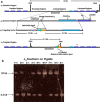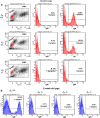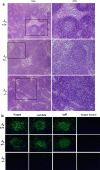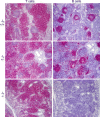Generation of antibody- and B cell-deficient pigs by targeted disruption of the J-region gene segment of the heavy chain locus
- PMID: 20872248
- PMCID: PMC7089184
- DOI: 10.1007/s11248-010-9444-z
Generation of antibody- and B cell-deficient pigs by targeted disruption of the J-region gene segment of the heavy chain locus
Abstract
A poly(A)-trap gene targeting strategy was used to disrupt the single functional heavy chain (HC) joining region (J(H)) of swine in primary fibroblasts. Genetically modified piglets were then generated via somatic cell nuclear transfer (SCNT) and bred to yield litters comprising J(H) wild-type littermate (+/+), J(H) heterozygous knockout (±) and J(H) homozygous knockout (-/-) piglets in the expected Mendelian ratio of 1:2:1. There are only two other targeted loci previously published in swine, and this is the first successful poly(A)-trap strategy ever published in a livestock species. In either blood or secondary lymphoid tissues, flow cytometry, RT-PCR and ELISA detected no circulating IgM(+) B cells, and no transcription or secretion of immunoglobulin (Ig) isotypes, respectively in J(H) -/- pigs. Histochemical and immunohistochemical (IHC) studies failed to detect lymph node (LN) follicles or CD79α(+) B cells, respectively in J(H) -/- pigs. T cell receptor (TCR)(β) transcription and T cells were detected in J(H) -/- pigs. When reared conventionally, J(H) -/- pigs succumbed to bacterial infections after weaning. These antibody (Ab)- and B cell-deficient pigs have significant value as models for both veterinary and human research to discriminate cellular and humoral protective immunity to infectious agents. Thus, these pigs may aid in vaccine development for infectious agents such as the pandemic porcine reproductive and respiratory syndrome virus (PRRSV) and H1N1 swine flu. These pigs are also a first significant step towards generating a pig that expresses fully human, antigen-specific polyclonal Ab to target numerous incurable infectious diseases with high unmet clinical need.
Conflict of interest statement
M. Mendicino, J. Ramsoondar, C. Phelps, T. Vaught, S. Ball, Y. Dai, J. Monahan, S. Chen, A. Dandro, J. Boone, P. Jobst, A. Vance, I. Polejaeva, K. Wells, and D. Ayares are or were employees of Revivicor, Inc.
Figures

 in A. A 22 kb band represents a non-targeted allele (see a). A 3.3 kb band represents a targeted allele (see a). The genotype is given along with the piglet number along the top of the blot
in A. A 22 kb band represents a non-targeted allele (see a). A 3.3 kb band represents a targeted allele (see a). The genotype is given along with the piglet number along the top of the blot



Similar articles
-
Generation of recombination activating gene-1-deficient neonatal piglets: a model of T and B cell deficient severe combined immune deficiency.PLoS One. 2014 Dec 1;9(12):e113833. doi: 10.1371/journal.pone.0113833. eCollection 2014. PLoS One. 2014. PMID: 25437445 Free PMC article.
-
Targeted disruption of the porcine immunoglobulin kappa light chain locus.Transgenic Res. 2011 Jun;20(3):643-53. doi: 10.1007/s11248-010-9445-y. Epub 2010 Sep 26. Transgenic Res. 2011. PMID: 20872247
-
Generation of B cell-deficient pigs by highly efficient CRISPR/Cas9-mediated gene targeting.J Genet Genomics. 2015 Aug 20;42(8):437-44. doi: 10.1016/j.jgg.2015.05.002. Epub 2015 May 27. J Genet Genomics. 2015. PMID: 26336800
-
Immunoglobulins, antibody repertoire and B cell development.Dev Comp Immunol. 2009 Mar;33(3):321-33. doi: 10.1016/j.dci.2008.06.015. Epub 2008 Sep 18. Dev Comp Immunol. 2009. PMID: 18804488 Review.
-
Fidelity and infidelity in commitment to B-lymphocyte lineage development.Immunol Rev. 2000 Jun;175:104-11. Immunol Rev. 2000. PMID: 10933595 Review.
Cited by
-
Assessment of fecundity and germ line transmission in two transgenic pig lines produced by sleeping beauty transposition.Genes (Basel). 2012 Oct 12;3(4):615-33. doi: 10.3390/genes3040615. Genes (Basel). 2012. PMID: 24705079 Free PMC article.
-
Use of single stranded targeting DNA or negative selection does not further increase the efficiency of a GGTA1 promoter trap.J Mol Cloning Genet Recomb. 2013 Mar 27;2(1):684. doi: 10.4172/2325-9787.1000101. J Mol Cloning Genet Recomb. 2013. PMID: 25309937 Free PMC article.
-
Generation of recombination activating gene-1-deficient neonatal piglets: a model of T and B cell deficient severe combined immune deficiency.PLoS One. 2014 Dec 1;9(12):e113833. doi: 10.1371/journal.pone.0113833. eCollection 2014. PLoS One. 2014. PMID: 25437445 Free PMC article.
-
Completion of the swine genome will simplify the production of swine as a large animal biomedical model.BMC Med Genomics. 2012 Nov 15;5:55. doi: 10.1186/1755-8794-5-55. BMC Med Genomics. 2012. PMID: 23151353 Free PMC article.
-
Comparative Aspects of Immunoglobulin Gene Rearrangement Arrays in Different Species.Front Immunol. 2022 Feb 11;13:823145. doi: 10.3389/fimmu.2022.823145. eCollection 2022. Front Immunol. 2022. PMID: 35222402 Free PMC article. Review.
References
-
- Butler JE, Sun J, Weber P, Navarro P, Francis D. Antibody repertoire development in fetal and newborn piglets, III. Colonization of the gastrointestinal tract selectively diversifies the preimmune repertoire in mucosal lymphoid tissues. Immunology. 2000;100:119–130. doi: 10.1046/j.1365-2567.2000.00013.x. - DOI - PMC - PubMed
Publication types
MeSH terms
Substances
LinkOut - more resources
Full Text Sources
Other Literature Sources

